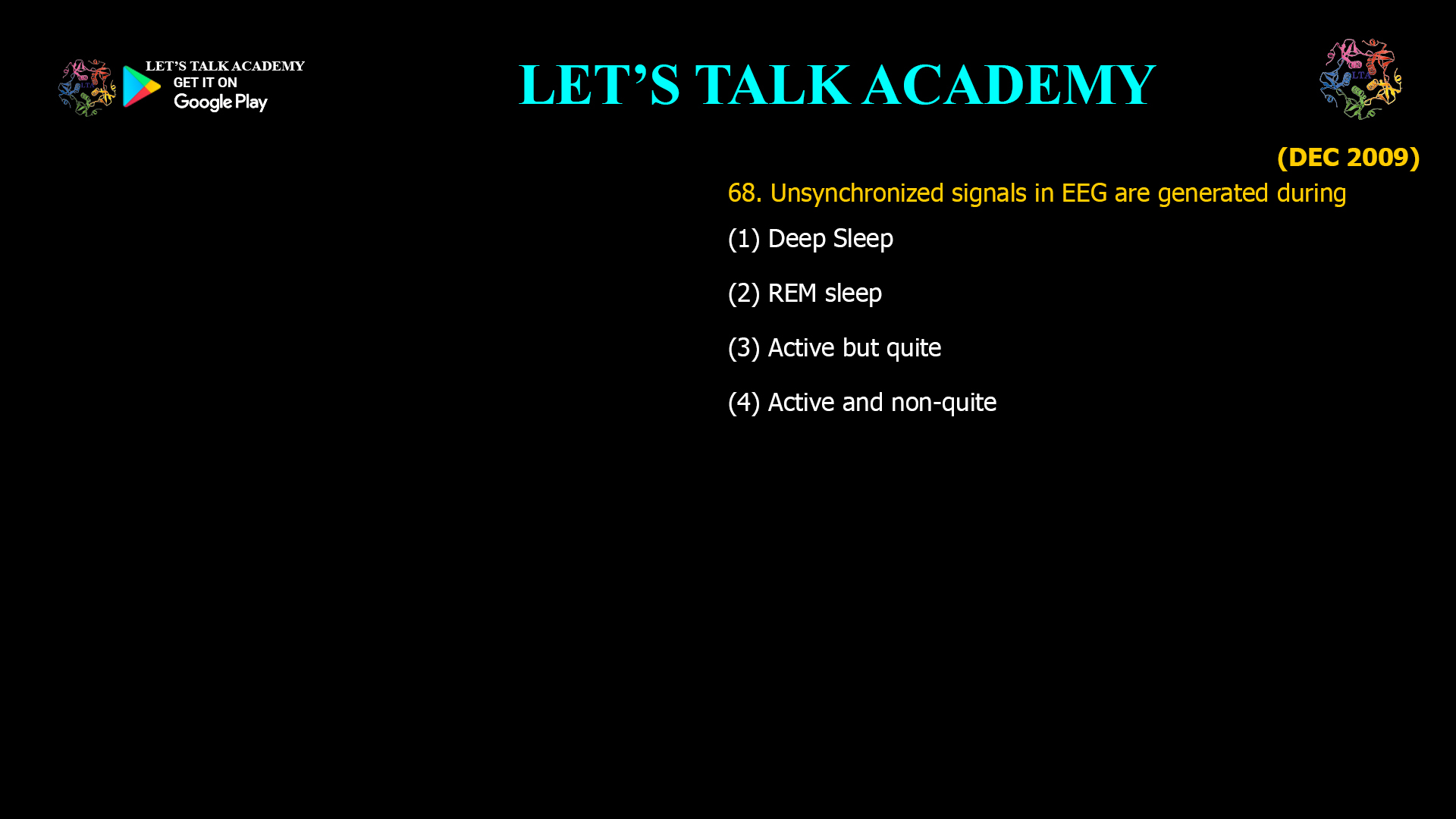- Unsynchronized signals in EEG are generated during
(1) Deep Sleep (2) REM sleep
(3) Active but quite (4) Active and non-quiteWhat Are Unsynchronized EEG Signals?
Unsynchronized EEG signals—also known as desynchronized or low-amplitude, mixed-frequency patterns—are characterized by rapid, irregular fluctuations in brain wave activity. Unlike synchronized signals, which display regular, high-amplitude waves, unsynchronized signals reflect a state of heightened cortical activity, with neurons firing in a less coordinated manner.
These patterns are commonly associated with states of alertness, active thinking, and certain phases of sleep, particularly REM (Rapid Eye Movement) sleep.
EEG Patterns Across Sleep Stages and Wakefulness
The human sleep cycle is divided into several stages, each with distinct EEG signatures:
-
Wakefulness (Active and Quiet)
-
Non-REM Sleep (N1, N2, N3/Deep Sleep)
-
REM Sleep
Each stage is marked by unique brain wave patterns, which can be broadly categorized as synchronized or unsynchronized.
Wakefulness: Active and Quiet States
During wakefulness, especially when a person is active and engaged in mental tasks, the EEG shows unsynchronized, low-amplitude, high-frequency beta and gamma waves. This pattern reflects the brain’s active processing of sensory information, problem-solving, and conscious thought.
In contrast, during quiet wakefulness (such as when relaxed with eyes closed), the EEG may show more synchronized alpha waves, but the pattern is still less regular than deep sleep.
Non-REM Sleep: Synchronized Signals Dominate
Non-REM sleep is divided into three stages:
-
N1 (Light Sleep)
-
N2 (Intermediate Sleep)
-
N3 (Deep or Slow-Wave Sleep)
As sleep deepens, EEG patterns become increasingly synchronized, characterized by high-amplitude, low-frequency delta waves, especially in N3 (deep sleep). This synchronization indicates that large groups of neurons are firing together in a coordinated rhythm, a hallmark of restorative sleep.
REM Sleep: Return of Unsynchronized Activity
REM sleep is unique. Although the body is deeply relaxed and muscle tone is lost, the brain becomes highly active. The EEG during REM sleep closely resembles that of wakefulness, displaying unsynchronized, low-amplitude, mixed-frequency waves. This desynchronization is associated with vivid dreaming, rapid eye movements, and increased brain metabolism.
When Are Unsynchronized EEG Signals Generated?
To answer the central question: Unsynchronized EEG signals are primarily generated during REM sleep and during active, alert wakefulness.
Let’s break down the options:
State EEG Pattern Type Description Deep Sleep (N3) Synchronized High-amplitude, low-frequency delta waves; neurons fire in unison REM Sleep Unsynchronized Low-amplitude, mixed-frequency waves; resembles wakefulness; vivid dreaming occurs Active but Quiet Wakefulness Mixed Alpha waves dominate when relaxed, but can show some desynchronization with sensory input Active and Non-Quiet Unsynchronized Beta/gamma waves; low-amplitude, high-frequency; reflects active thinking and alertness Correct answers:
-
REM Sleep
-
Active and Non-Quiet Wakefulness
Why Do Unsynchronized EEG Signals Occur?
Unsynchronized EEG signals reflect complex, dynamic brain activity. During REM sleep and wakeful alertness, the brain is processing information, integrating sensory inputs, and forming memories. This requires a high degree of neural flexibility, with different brain regions communicating rapidly and independently.
In contrast, synchronized patterns during deep sleep are thought to support restorative processes, such as memory consolidation and cellular repair, by allowing large neural populations to act in concert.
Significance of Unsynchronized EEG in REM Sleep
REM sleep is sometimes called “paradoxical sleep” because, despite the body being immobile, the brain is highly active. The unsynchronized EEG signals during REM sleep are linked to:
-
Vivid Dreaming: The brain’s activity during REM supports the complex, immersive experiences of dreams.
-
Emotional Processing: REM sleep is crucial for emotional regulation and memory integration.
-
Brain Plasticity: The dynamic EEG patterns may facilitate synaptic changes important for learning and adaptation.
Unsynchronized EEG and Consciousness
Research shows that signal diversity and complexity in the EEG are higher during REM sleep and wakefulness compared to deep sleep. These measures are considered correlates of conscious experience, supporting the idea that unsynchronized EEG activity underlies richer, more complex mental states.
Clinical Relevance
Understanding when unsynchronized EEG signals occur is vital for:
-
Sleep Medicine: Diagnosing sleep disorders and understanding abnormal brain activity during sleep.
-
Neuroscience Research: Exploring the neural basis of consciousness and cognition.
-
Brain-Computer Interfaces: Designing systems that respond to different states of alertness or sleep.
Conclusion
Unsynchronized EEG signals are generated during REM sleep and during active, alert wakefulness. These patterns reflect the brain’s dynamic, flexible processing required for consciousness, dreaming, and cognitive function. In contrast, synchronized EEG patterns dominate during deep, restorative sleep. Recognizing these differences is essential for understanding the brain’s complex rhythms and their impact on health and behavior.
-




1 Comment
Kajal
October 15, 2025REM sleep